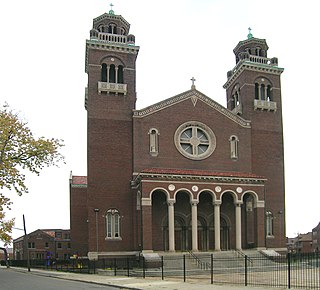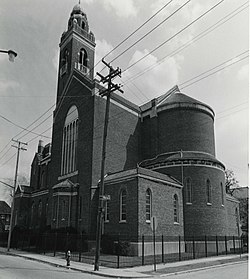
St. Mary Cathedral is a cathedral of the Roman Catholic Church in Lansing, Michigan one block north of the Michigan State Capitol. It is the seat of the bishop of the Roman Catholic Diocese of Lansing.

The Sweetest Heart of Mary Roman Catholic Church is located at 4440 Russell Street in Detroit, Michigan, in the Forest Park neighborhood on the city's central East side. It was designated a Michigan State Historic Site in 1974 and listed on the National Register of Historic Places in 1978. It, along with St. Albertus Roman Catholic Church, 0.4 miles east on East Canfield Street, and St. Josaphat Roman Catholic Church, 0.3 miles west at East Canfield Street and Chrysler Drive, served the large Polish community through most of the twentieth century. In a diocesan reorganization instituted by Archbishop Allen Vigneron in 2013, Sweetest Heart of Mary joined with St. Josephat to form Mother of Divine Mercy Parish.

The Sugar Hill Historic District is a historic district in Detroit, Michigan. It contains 14 structures located along three streets: East Forest, Garfield, and East Canfield, between Woodward Avenue on the west and John R. on the east. The district was listed on the National Register of Historic Places in 2003.

The Chapel of St. Theresa–the Little Flower was a church located at 58 Parsons Street in Midtown Detroit, Michigan. It was later known as St. Patrick Church. The building was listed on the National Register of Historic Places in 1997, and demolished in September 2023.

St. Josaphat Roman Catholic Church is a Roman Catholic church located at 715 East Canfield Street in Detroit, Michigan. It was listed on the National Register of Historic Places in 1982 and designated a Michigan State Historic Site in 1985. Since 2013, it has been one of two churches that comprise Mother of Divine Mercy Parish.

St. Boniface Roman Catholic Church was a Roman Catholic church located at 2356 Vermont Avenue in Detroit, Michigan. It was also known as St. Boniface-St. Vincent Roman Catholic Church. The church was designated a Michigan State Historic Site in 1983 and listed on the National Register of Historic Places in 1989, but was subsequently demolished in 1996. The church was removed from the NRHP in 2022.

The St. Theresa of Avila Roman Catholic Church is a church located at 8666 Quincy Street in Detroit, Michigan. It was listed on the National Register of Historic Places in 1989.

St. Charles Borromeo Roman Catholic Church is a church located at the corner of Baldwin Avenue and St. Paul Avenue in Detroit, Michigan. The church address is 1515 Baldwin Street; The church address is 1515 Baldwin Street; the parish rectory is located at 1491 Baldwin and sits next door to the church. The complex was listed on the National Register of Historic Places in 1989.

The St. Catherine of Siena Roman Catholic Church is a church located at 4151 Seminole Street in Detroit, Michigan. It is now the St. Augustine and St. Monica Roman Catholic Church. The church was listed on the National Register of Historic Places in 1991.

The Jefferson–Chalmers Historic Business District is a neighborhood located on East Jefferson Avenue between Eastlawn Street and Alter Road in Detroit, Michigan. The district is the only continuously intact commercial district remaining along East Jefferson Avenue, and was listed on the National Register of Historic Places in 2004.

St. Mary's Catholic Church, also known as St. Mary of the Visitation Church, is a parish church of the Diocese of Davenport which is located in Iowa City, Iowa, United States. The church building and rectory were listed together on the National Register of Historic Places in 1980. They were both included as contributing properties in the Jefferson Street Historic District in 2004. The parish's first rectory, which is now a private home, is also listed on the National Register as St. Mary's Rectory. It is located a few blocks to the east of the present church location at 610 E. Jefferson St.

St. Joseph's Catholic Church is a former parish of the Diocese of Davenport. The church is located in Dallas township in rural Marion County, Iowa, United States. It was part of the now defunct village of Bauer. The closest communities are Melcher-Dallas and Lacona. The church building still stands and together with the adjacent cemetery comprises an historic district listed on the National Register of Historic Places.

St. Mary's Catholic Church is a parish church of the Diocese of Davenport. The church is located at the corner of St. Mary's and Washburn Streets in the town of Riverside, Iowa, United States. The entire parish complex forms an historic district listed on the National Register of Historic Places as St. Mary's Parish Church Buildings. The designation includes the church building, rectory, the former church, and former school building. The former convent, which was included in the historical designation, is no longer in existence.

St. Boniface Catholic Church is a parish of the Diocese of Sioux City. The church is located in a residential area west of downtown Sioux City, Iowa, United States. The parish buildings form a nationally recognized historic district that was listed on the National Register of Historic Places in 1998 as St. Boniface Historic District. At the time of its nomination it contained three resources, all of them contributing buildings.

Saint John the Evangelist Catholic Church is a Catholic parish of the Archdiocese of Indianapolis in Indianapolis, Indiana, United States. The parish's origins date to 1837, when it was first named Holy Cross parish. In 1850 it was renamed Saint John the Evangelist parish, and is the oldest Catholic parish in the city and in Marion County, Indiana. Considered the mother of the Catholic parishes in Indianapolis, it played an important role in development of the Catholic Church in the city. Saint John's Church served as the pro-cathedral of the diocese from 1878 until 1906; its rectory served as the bishop's residence and chancery from 1878 until 1892. In 1900 the church served as the site of first episcopal consecration held in Indianapolis.

St. John the Baptist Catholic Church is a historic church, with an associated rectory, school, and cemetery, located at 324 S. Washington Avenue in Hubbardston, Michigan. The church was built in 1868. It was added to the National Register of Historic Places and listed as a Michigan State Historic Site in 2001. The parish is clustered with St. Mary parish in Carson City, Michigan.

St. Augustine Catholic Church and Cemetery is a historic site in Hartland, Michigan. It is associated with Fr. Patrick O’Kelly, a missionary priest who was active in Southeastern Michigan. The church was built in 1843 and added to the National Register in 1996.

Saints Peter and Paul Roman Catholic Church Complex is located in Milwaukee, Wisconsin. The complex was added to the National Register of Historic Places in 1991 for its architectural significance.

The Church of the Transfiguration Historic District is a group of buildings associated with what was the Church of the Transfiguration Roman Catholic parish, located at 5830 Simon K in Detroit, Michigan. It was listed on the National Register of Historic Places in 2019.

Saint Matthew Parish is Catholic church located at 6021 Whittier Avenue in Detroit. It was listed on the National Register of Historic Places in 2023.




























